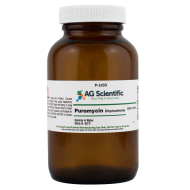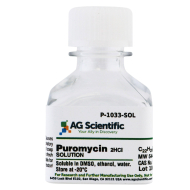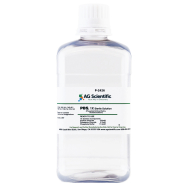Exciting advances in the study of protein synthesis and related health conditions are on the horizon! Research scientists have developed an improved process to quantify and understand the processes of protein synthesis in singular eukaryotic cells/cell populations. It’s called the surface sensing of translation, or SUnSET assay. It is a nonradioactive fluorescence-activated assay, which means SUnSET assay effectively quantifies and measures protein synthesis with minimal exposure to radioactive materials!

For decades, scientists have relied upon radioactive isotopes as tracers to study protein synthesis, and harmful side-effects have not gone unnoticed. Radiation from such isotopes can pose long-term health risks, such as cancer. Stable materials have historically not been as effective in quantifying and observing cell processes. But scientists have now discovered that the SUnSET assay technique can achieve similar results with minimal negative side effects.
For example, in a recent experiment the SUnSET assay method was utilized with puromycin. Researchers compared this with the traditional method using two radioactive amino acids: cysteine and methionine. The result? SUnSET assay is a safer alternative!
Defining and Measuring Protein Synthesis
Protein synthesis is the process by which a cell makes new proteins, producing single-strand copies of DNA called RNA that are translated and then reproduced again. This process occurs in all living cells and is our genetic coding in action.
SUnSET assays are proving helpful in the study of protein synthesis, genetics and more specifically, mutations that cause mammalian diseases and disorders. Unfortunately, proteins sometimes “fold” incorrectly, leading to mutation. Mutated cells/proteins can then trigger the onset of a disease such as cancer or Alzheimer’s, or can cause neural developmental disorders like Fragile X syndrome.
Fragile X Syndrome
Fragile X syndrome is caused by a mutation of the FMR1 gene that prevents synthesis of an incredibly important protein called FMRP. FMRP is used by the body to make connections in brain cells and the central nervous system. A lack of FMRP can cause the brain to send incorrect signals, leading to developmental and learning disabilities. A recent study focused on why drug therapies have so far failed to be effectively produced to manage protein synthesis for treatment of Fragile X Syndrome. The researchers utilized a SUnSET assay to evaluate effects of various rates of protein synthesis.
The researchers used puromycin in their SUnSET assay with FXS fibroblasts. Puromycin is a stable antibiotic protein synthesis inhibitor, meaning it cuts cell translation short by terminating the RNA chain in the ribosome. The study noted the use of puromycin in SUnSET assays as an effective and preferred method of studying protein synthesis. Let’s take a look at some other experiments utilizing SUnSET assays and explore the common reagents needed to conduct research using this method.
Fruit Fly Experiment
As previously noted, puromycin is a choice reagent in SUnSET assays for puromycin-labeling. In a recent biochemical experiment, scientists used puromycin and an anti-puromycin antibody in Drosophila larvae, more commonly known as “fruit flies”. They chose Drosophila larvae because it is easy to alter their protein synthesis pathways using the SUnSET assay method, and they are an excellent representative of animal physiology.
By injecting the larvae with puromycin, scientists were able to study the rate of protein synthesis using fluorescence markers. They also “compared the effects of carrying out the puromycin labeling in media versus phosphate-buffered saline (PBS). They found there was less incorporation of puromycin when tissues were incubated with PBS. In addition, they studied the TORC1 pathway, also known as the mammalian target of rapamycin complex 1, which is a protein complex that controls protein synthesis. They studied the pharmacological effects of introducing rapamycin, and found that protein synthesis was markedly decreased. This experiment is a promising example of alternative ways to study protein synthesis without resorting to using radioactive isotopes!
Plants Too!
SUnSET assays are a credible method of studying animal protein synthesis, but as this researcher notes, it also is helpful in safely studying plant life! Arabidopsis plants were studied to determine whether proteasome inhibition decreased the rate of protein synthesis, and if SUnSET assay could be used to measure this. The plants were treated with small amounts of puromycin so as not to be lethal, and it found that confirmed that puromycin does indeed inhibit protein synthesis.
The researcher was also curious to see if SUnSET is an accurate method to measure whether the plants under stress would also see a decrease in protein synthesis, and in fact, it was! The plants were introduced to salt stress or sulfur starvation, and the SUnSET assay technique was used to quantify the effect of these two conditions on protein synthesis. The SuNSET assay showed a marked decrease in protein synthesis! Being able to study cellular processes in plants is critical, as protein synthesis is the main form of cellular generation, just as in animal eukaryotic cells.
Conclusion of Recent Findings
As always, improvements on widely used research methods can be exciting news, and new methods of study are even more thrilling. The processes of cellular formation and protein synthesis are critical to understand as we move towards a goal of treating and eliminating diseases & disorders. SUnSET assays have proven to provide accurate results in studying DNA coding and protein synthesis in both animal and plant cells without the use of unstable, radioactive isotopes as reagents. We look forward to seeing more research on the effectiveness of SUnSET assays, and AG Scientific is ready to supply your lab with the highest quality materials to do so!Your Ally in Discovery
At AG Scientific we are proud to serve our customers in the scientific community by offering the highest quality raw materials for breakthrough research. We source Puromycin, Phosphate Buffered Saline, and rapamycin, among other antibiotics, enzymes, and reagents, in addition to tailoring custom reagents to meet your needs.Questions? Contact our team - we are here to support you and your research endeavors.




